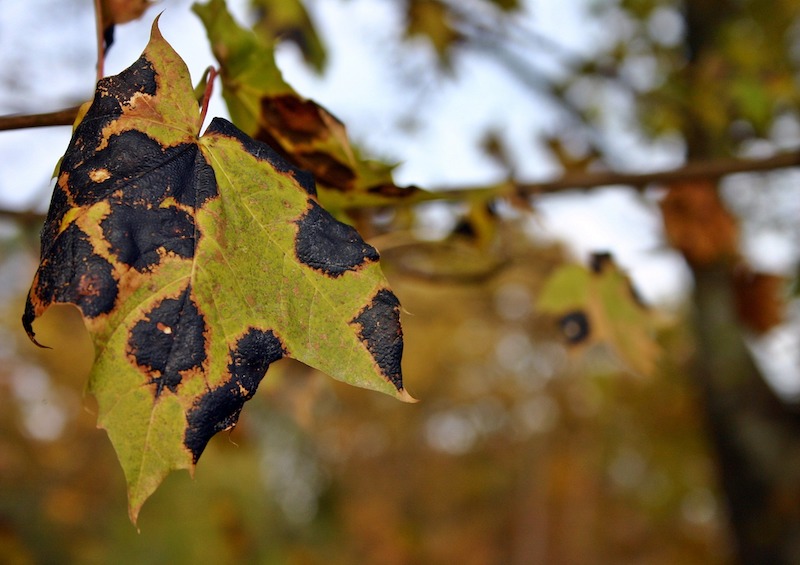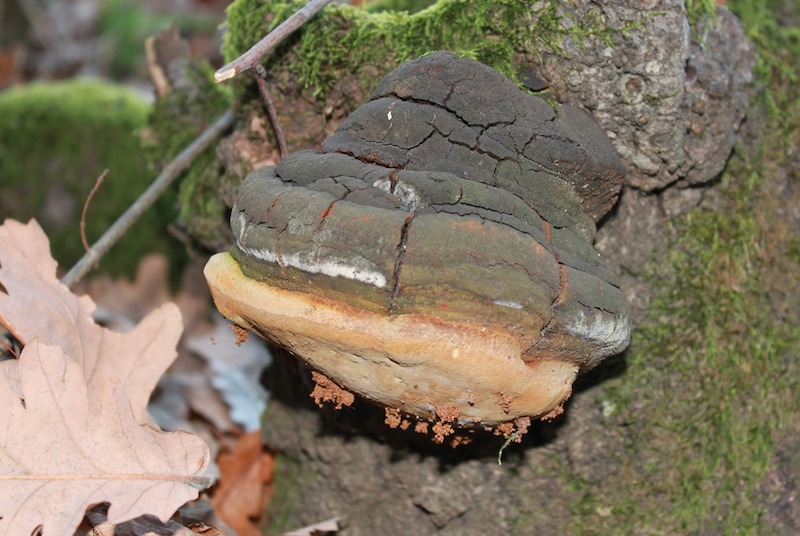With their beautiful boughs of lush foliage, maples are low maintenance and relatively disease resistant. These trees should remain relatively healthy with regular pruning, fertilizing, and watering. However, occasionally, they do get sick. They can suffer from anthracnose, leaf spot, root rot, and verticillium wilt. All four of these diseases are caused by fungi and are commonly contracted during moderate temperatures and heavy moisture. Depending on which disease, treatment ranges between pruning dead branches to complete tree removal.

Maple Anthracnose
During cool periods, maple trees such as red, sugar, silver, and Japanese can contract anthracnose, a fungal disease. Fungi that cause this disease include Discula and Kabatiella. Dark spots and fruiting bodies develop along the veins in the leaves. Lesions may also develop along the limbs. Depending on the tree's age, maples can sometimes survive anthracnose without treatment.
Identifying Anthracnose
Dark brownish areas and fruiting bodies developing along leaf veins typically characterize anthracnose. Twig cankers may also form along the tree’s branches.
Treating Anthracnose
Depending on the severity of the issue, mature maple trees can survive anthracnose without any treatment. Young trees, however, usually need a fungicide. Either way, trim any diseased/dead/damaged limbs, and rake up and remove any dead leaves and twigs from the ground. Then, treat with a copper-based fungicide. Do not apply it during hot temperatures to prevent leaf burn from the fungicide. You can also treat maple with Bordeaux mixture, a combination of copper (copper sulfate), lime (calcium hydroxide), and water mixed at a ratio of 4-4-10. Mix 1.28 ounces of copper and 1.28 ounces of lime with 1 gallon of water to make a reasonable-sized batch.

Maple Leaf Spot
While relatively disease resistant, maple trees sometimes suffer from leaf spot, a fungal disease caused by Phyllosticta minima. These fungi hang around the maple tree among its dead leaves during the winter to make another show during the following spring. The disease they cause is identified by light-colored blotches encircled by purplish rings and dotted with blackish spots in their middles. As a result, if the problem is acute and left untreated, the tree may suffer from partial defoliation.
Identifying Leaf Spot
Maple leaf spot is characterized by small pale circular blotches enclosed by dark rings and marked with dark spots in their centers. Additionally, fungal fruiting bodies are present in these discolored areas.
Treating Leaf Spot
Trim dead limbs. Rake up and remove all twigs and dead foliage. Then, depending on the severity of the problem, treat it with a copper-based fungicide or Bordeaux mixture. Bordeaux mixture combines copper (copper sulfate), lime (calcium hydroxide), and water mixed at a ratio of 4 pounds of copper to 4 pounds of lime to 50 gallons of water. Mix 1.28 ounces of copper, 1.28 ounces of lime, and 1 gallon of water to make a smaller batch.
Maple Root Rot
Root rot caused by Fomes fomentarius is a terrible threat to maple trees. Identified by fungal fruiting bodies in the forms of hooves growing along the tree’s bark, a maple suffering from root rot may start to lose limbs as they die, creating danger for those walking beneath it. A maple tree sick with root rot should be cut down and removed immediately.
Identifying Root Rot
Hoof-like shaped fungal fruiting bodies growing on the bark characterize maple trees sick with root rot caused by Fomes fomentarius. Trees suffering from this disorder may also display signs of chlorosis.

Treating Root Rot
In the case of root rot, once Fomes fomentarius has infiltrated a maple tree, the only option typically left is to remove the tree. Root rot can cause limbs to die, so a tree left standing with root rot is dangerous to humans and animals walking beneath its dying branches.
Maple Verticillium Wilt
Another disease that infects maple trees is verticillium wilt. This fungal disease, also known as maple wilt, can cause the tree to die. This disease is characterized by dieback, foliage that appears burned, and tree cankers. Fungi damage the tree’s xylem, or water transport vascular system, after entering the tree through its roots.
Identifying Verticillium Wilt
Verticillium wilt is identified by burned-looking foliage, dying branches and twigs, and tree cankers, which are dead spots of tree bark.
Treating Verticillium Wilt
Since fungi that cause verticillium wilt live in the surrounding soil, treatment options will depend on the severity of the illness. No fungicide currently exists to treat this disease. If the problem is not severe, proper watering, pruning, and fertilizing should help the tree continue to live. If, however, the issue is severe, then tree removal should be considered.
Maple Disease Chart
|
Disease |
Identifying |
Treating |
|
Maple Anthracnose |
Dark spots along veins on leaves |
Prune/Copper Fungicide |
|
Leaf Spots on Maples |
Pale spots on leaves |
Prune/Copper Fungicide |
|
Maple Root Rot |
Hoof-shaped bodies on bark |
Tree removal |
Sources:
"Common Diseases of Maple." Connecticut State - The Connecticut Agricultural Experiment Station. portal.ct.gov
"Maple—Acer spp." University of California Integrated Pest Management. ipm.ucanr.edu
 |
Author Suellen Barnes - Published 4-27-2023 |
